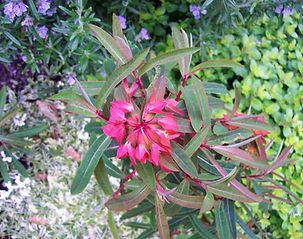Get a sense of Euphorbia: growing from seed
Never mind the irritant, toxic sap, they're great to look at
EUPHORBIAS are one of my favourite plant families. They have their down side (poisonous, irritating sap) but we all have family members like that, don't we? Here's my top five:
Euphorbia x martinii Ascot Rainbow: a must for late winter/spring colour. It forms a neat, evergreen clump of slender blue-green leaves, edged creamy yellow, flushed with red in colder weather. Spikes of cream, lime and green flowers later in spring. It only grows 50-60cm high and will tolerate light shade. Not a lover of heavy soil, it does best when planted in well-drained soil and is great for winter containers.
E. characias subsp. wulfenii: an erect, sparsely-branched medium-sized sub-shrub with oblong, grey-green leaves and large, rounded heads of lime-yellow flowers. In good conditions, it will grow to 1-1.5 metres, with a similar spread. Hardy down to -5C. They're more at risk of frost damage in pots, or from sudden, early frosts, so beware.
E. myrsinites: an evergreen ground cover plant, hardy with exotic looks. Succulent-like leaves that sprawl on blue-green stems. The typical lime/yellow flowers appear in spring to early summer. It does best in full sun, growing to just 10cm high, but with a spread of 0.5m per plant.
E. griffithii Fireglow: a vigorous perennial that will spread through ground cover plants with upright stems clothed in narrow, red-tinged leaves and orange-red flowers in early summer. Mine bursts its way through golden oregano. It's hardy, with a height of 0.5-1 metres, and a similar spread. If you garden on a light soil, you may find it a little invasive!
E. polychroma Purpurea: very early yellow-green bracts with purple-tinged leaves. This Euphorbia prefers to be planted in partial shade in moist, well-drained soil and grows to 40cm. Some of the other purple-leaved varieties are martyrs to mildew, but this one seems OK so far.




From top, Euphorbia x martinii Ascot Rainbow; E. characias subsp. wulfenii; E. griffithii Fireglow; E. myrsinites.
Pruning rules...
EUPHORBIAS, especially the bigger E. wulfenii types, tend to get very leggy and untidy. Most euphorbia species bloom at the tips of stems that grew the year before.
The general rule of thumb is after flowering, cut out all flowered stems at the base, leaving new growth to shoot up. If you hack everything down to the ground, you'll lose next year's flowers.
Poisonous: beware!
ALL euphorbias have a white, toxic, milky sap that causes an itchy rash and possible blistering on contact.
Getting sap in your eyes is painful, and can even cause blindness.
Gloves and protective clothing are a must when trimming back.
IT'S worth having a go at growing Euphorbias from seed. I bought Euphorbia Mixed from Plant World Seeds, they germinated easily and I now have loads of plants, some of which have flowered in the first year.
There are some I can't identify, but the mix does contain some unnamed rarities.
They range from 45cm-1.2m, are all hardy perennials, price £2.95.
Sowing advice
I sowed mine in spring on to a good soil-based compost and covered with Perlite to approximately their own depth.
They were kept at 15 to 20 degrees C, pricked out into modules, then potted on and hardened off outside.
My little nursery bed is full of them!
Easy from seed

Nursery bed full of seed-grown Euphorbias, flowering in their first year.


